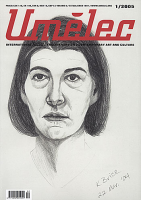| Umělec 2005/1 >> Black and White Clones | Просмотр всех номеров | ||||||||||||
|
|||||||||||||
Black and White ClonesUmělec 2005/101.01.2005 Simona Pavlicová | review | en cs |
|||||||||||||
|
Alena Kotzmanová, Cyclone
December 2004–January 2005 Jelení Gallery, Prague The work of Alena Kotzmanová (b. 1974) seems to surpass all the postmodern tendencies, excesses and peculiarities, as well as the esthetics of surprise and shock. Nevertheless, it manages to touch in a unique way the introspective visual icon hidden in the depths of the soul. Already Alena Kotzmannová’s portfolio is spectacular for someone her age. She has frequently exhibited locally and abroad. Last summer, the Center for Contemporary Art selected her for a three-month scholarship at the International Studio and Curatorial Program in New York. The bright lights of that chaotic metropolis enchanted her so much that she returned for another month in the autumn. The three plus one months gave birth to her most recent project entitled Cyclone. That ought to herald a publication of the same name. As an element of atmospheric disturbance, the cyclone has been a feature on the American continent since time immemorial. It periodically returns in various spiral twists, dynamic as life itself. This constant changing when things, situations and events constantly transform, is significant for the exhibition in the Jelení Gallery. Cyclone poetically alludes not only to atmospheric shifts but also to the photographic shutter that Kotzmanová uses to transpose non-art information to art, and ironically addresses cloning—a doubling praised as much as it is derided. Seemingly identical photographs formed the core of the show. The clones were divided into two rooms each in different rooms. It was left up to the viewer to look for the twins and discover the optical alteration and distortions in time. At first glance Kotzmanová seems to have simply documented various places: empty factories, a Coney Island park where New York yuppies spend their free time, the Brooklyn docks, MoMA, and golf courses. Yet she has managed an unexpected meditative effect expressing a penetratingly romantic insight. Alena Kotzmanová knows how to look. She chooses such angles of view in which the impact of something new unsettles her. There is no artificial arrangement in front of the lens; instead, there is a permanent search, as if she held a small, portable camera in her head. It is research, the conquering of new, unusual visions, getting to know and understand - if understanding is possible given the biological limits of our brain. Her works don’t lose their aura because instead of fully repeating their meaning is shifted into a different meta-level of being. Places or shapes, that sometimes seem hardly graspable, appear familiar in a different shot. Kotzmannová’s shots are unique and perfect in style. They radiate a desire for compositional tranquility, which is gained in spite of the dynamic conception of space. They capture the genius loci in the loops between past and present. The New York destinations enjoy a mixture of modern and retro. And the artist has such a sense for rhythm that you feel like the actions in the shots flow around you, like water. More important, however, is her slightly dreamy photos that assert the simple philosophical fact that time doesn’t really exist.
01.01.2005
Рекомендуемые статьи
|
|||||||||||||







Комментарии
Статья не была прокомментированаДобавить новый комментарий